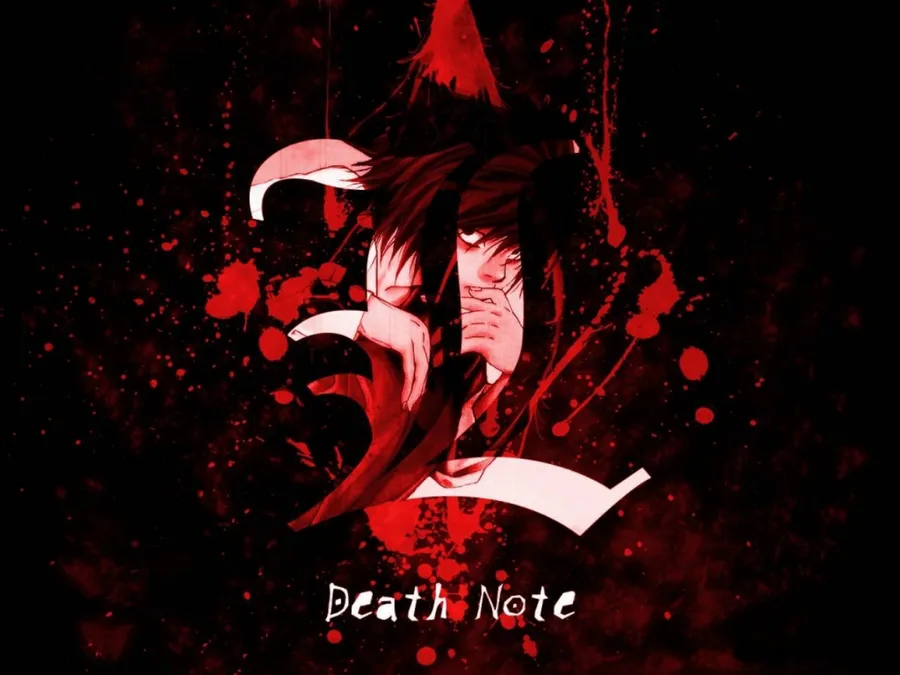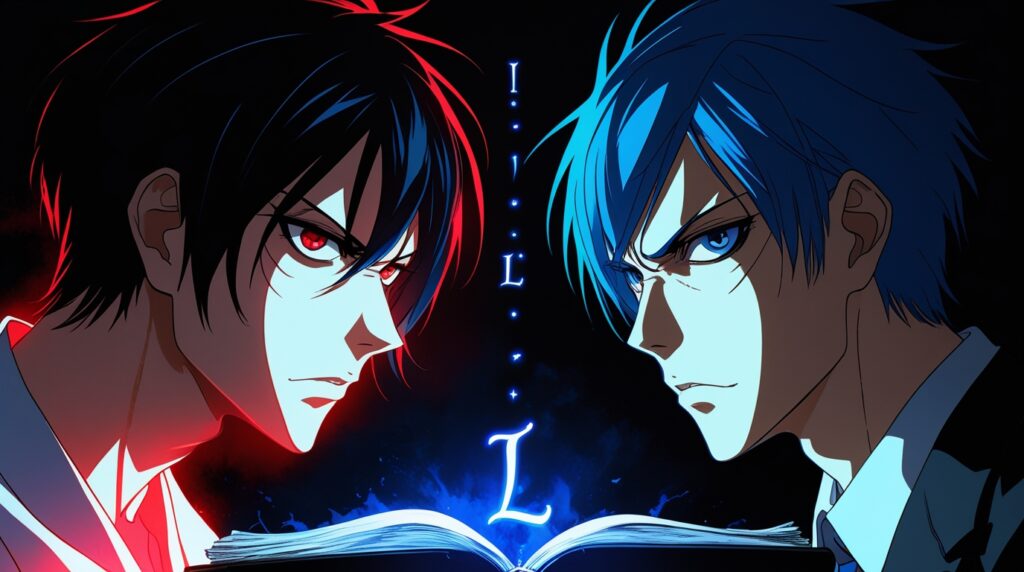Death Note anime theories and facts go deeper The Death Note anime isn’t just popular because of its story. It’s the psychological war, layered symbolism, and how it makes the viewer question right and wrong. But beyond the surface, there are facts, theories, and character deaths that fans still debate years later. Here’s everything that matters, without the fluff.
What Made Death Note So Unique?

| Top Death Note Anime Theories That Make Sense |
Death Note flipped the hero-villain narrative. The protagonist, Light Yagami, becomes the antagonist. The real hero, L, isn’t even introduced until episode 2. And the “power” in this anime isn’t strength or magic — it’s intelligence. It’s about who makes the next best move.
The concept of the Death Note itself is simple: write a name, and they die. But the show uses it to explore obsession, ego, justice, and control. That’s what made it stand out. No flashy fights, just strategy and morality.
Confirmed Facts Most Fans Miss
1. The Story Almost Ended at Episode 25
Death Note was supposed to end with L’s death. Many fans consider the first 25 episodes the real Death Note. After that, the tone changes. The studio pushed for a full-length series, so Near and Mello were introduced to replace L — but the same energy never returned.
2. L’s Real Name Was a Secret in the Anime, But Not the Manga
L’s full name, L Lawliet, is never spoken aloud in the anime. Only shown in written form once. In the manga and official data books, it’s confirmed. This adds to L’s mystique — he knows everything about Light, but Light doesn’t even know his name.
3. Light Yagami’s Name Meaning Is Symbolic

“Yagami” means “night god” if broken in Japanese kanji. Light literally becomes a god of death during the show. “Light” versus “L” also reflects duality — Light (Yagami) represents control and manipulation, while L represents truth and logic.
4. Every Death Follows the Shinigami Rules Exactly
No shortcuts. The show never breaks its own rules. When Light manipulates death scenes to the minute, it follows the notebook mechanics. That consistency makes every move feel real.
5. The Ending Scene Mirrors Episode 1
In the first episode, Light walks past Ryuk with a clean face. In the last, he’s wounded, panicked, and broken — while Ryuk watches silently again. It’s a full-circle moment. Ryuk promised it wouldn’t end well. He was right.
Best Fan Theories That Actually Make Sense
1. L Suspected He Would Die and Let It Happen
L knew he was going to lose. That’s why he left behind enough breadcrumbs for Near and Mello. Some fans believe L was intentionally setting up his successors, knowing Light’s ego would blind him once L was gone.
2. Ryuk Was Never on Light’s Side
Many first-time viewers think Ryuk is Light’s ally. He’s not. He’s just entertained. Ryuk doesn’t interfere because he’s watching it all like a game. He even tells Light in the beginning: “I’ll write your name in my notebook when the time comes.” That was never a joke.
3. Light Didn’t Win Because He Became What He Hated
Light started with a sense of justice — to rid the world of criminals. But power corrupted him. He killed innocent people, used others like tools, and justified everything in the name of becoming a god. The show isn’t about justice. It’s about how fast morality slips when ego takes over.
4. Misa Was Controlled by the Death Note Till the End
Misa lost her memories after giving up the notebook, but some theories say the damage was already done. Her dependency on Light, obsession with Kira, and loyalty all point to psychological control that outlived the notebook’s power.
Main Characters Who Died in Death Note
Death in Death Note is always calculated. These weren’t random. Each one served a purpose in the story.
🔴 L (L Lawliet)
How: Killed by Rem writing his name to protect Misa.
Why It Mattered: It marked Light’s rise to absolute power. It also showed the cost of love from a Shinigami — Rem dies for breaking her own rules.
🔴 Rem
How: Disintegrated after killing L.
Why It Mattered: Proved that even death gods could feel emotion, and it also removed another threat to Light.
🔴 Watari
How: Killed by Rem along with L.
Why It Mattered: He was L’s handler, his only connection to the outside world. Without him, L had no support system.
🔴 Mello
How: Died during the final arc trying to expose Kira.
Why It Mattered: His reckless style contrasts with Near’s logic. His death gave Near the final proof he needed.
🔴 Light Yagami
How: Shot multiple times, then dies from blood loss. Ryuk writes his name in the Death Note.
Why It Mattered: It’s the conclusion to the idea of self-made justice. Ryuk said from the start — he’d write Light’s name. In the end, it wasn’t Near or the police who ended him. It was his own Shinigami.
Death Note’s Impact on Anime and Pop Culture
- Inspired dozens of psychological anime: Code Geass, Psycho-Pass, Monster.
- Led to live-action movies, dramas, and a (badly received) Netflix version.
- It’s one of the few anime where no superpowers or battles exist — just logic and manipulation.
- Used in psychology courses as a study of anti-heroes, narcissism, and utilitarian ethics.
Final Thoughts
Death Note isn’t perfect. But it does something very few shows manage — it makes you question yourself. Would you use the notebook? Could you stop? Would you do better than Light?
That’s why people still talk about it years later. Not because of who won or lost, but because it reflects something deeper: the line between justice and control is razor thin, and it only takes one step to fall off.
Death Note Anime Theories and Facts: Mind Games, Deaths, and Hidden Truths
The Death Note anime isn’t just popular because of its story. It’s the psychological war, layered symbolism, and how it makes the viewer question right and wrong. But beyond the surface, there are facts, theories, and character deaths that fans still debate years later. Here’s everything that matters, without the fluff.
What Made Death Note So Unique?
Death Note flipped the hero-villain narrative. The protagonist, Light Yagami, becomes the antagonist. The real hero, L, isn’t even introduced until episode 2. And the “power” in this anime isn’t strength or magic — it’s intelligence. It’s about who makes the next best move.
The concept of the Death Note itself is simple: write a name, and they die. But the show uses it to explore obsession, ego, justice, and control. That’s what made it stand out. No flashy fights, just strategy and morality.
Confirmed Facts Most Fans Miss
1. The Story Almost Ended at Episode 25
Death Note was supposed to end with L’s death. Many fans consider the first 25 episodes the real Death Note. After that, the tone changes. The studio pushed for a full-length series, so Near and Mello were introduced to replace L — but the same energy never returned.
2. L’s Real Name Was a Secret in the Anime, But Not the Manga
L’s full name, L Lawliet, is never spoken aloud in the anime. Only shown in written form once. In the manga and official data books, it’s confirmed. This adds to L’s mystique — he knows everything about Light, but Light doesn’t even know his name.
3. Light Yagami’s Name Meaning Is Symbolic
“Yagami” means “night god” if broken in Japanese kanji. Light literally becomes a god of death during the show. “Light” versus “L” also reflects duality — Light (Yagami) represents control and manipulation, while L represents truth and logic.
4. Every Death Follows the Shinigami Rules Exactly
No shortcuts. The show never breaks its own rules. When Light manipulates death scenes to the minute, it follows the notebook mechanics. That consistency makes every move feel real.
5. The Ending Scene Mirrors Episode 1
In the first episode, Light walks past Ryuk with a clean face. In the last, he’s wounded, panicked, and broken — while Ryuk watches silently again. It’s a full-circle moment. Ryuk promised it wouldn’t end well. He was right.
Best Fan Theories That Actually Make Sense
1. L Suspected He Would Die and Let It Happen
L knew he was going to lose. That’s why he left behind enough breadcrumbs for Near and Mello. Some fans believe L was intentionally setting up his successors, knowing Light’s ego would blind him once L was gone.
2. Ryuk Was Never on Light’s Side
Many first-time viewers think Ryuk is Light’s ally. He’s not. He’s just entertained. Ryuk doesn’t interfere because he’s watching it all like a game. He even tells Light in the beginning: “I’ll write your name in my notebook when the time comes.” That was never a joke.
3. Light Didn’t Win Because He Became What He Hated
Light started with a sense of justice — to rid the world of criminals. But power corrupted him. He killed innocent people, used others like tools, and justified everything in the name of becoming a god. The show isn’t about justice. It’s about how fast morality slips when ego takes over.
4. Misa Was Controlled by the Death Note Till the End
Misa lost her memories after giving up the notebook, but some theories say the damage was already done. Her dependency on Light, obsession with Kira, and loyalty all point to psychological control that outlived the notebook’s power.
Main Characters Who Died in Death Note
Death in Death Note is always calculated. These weren’t random. Each one served a purpose in the story.
🔴 L (L Lawliet)
How: Killed by Rem writing his name to protect Misa.
Why It Mattered: It marked Light’s rise to absolute power. It also showed the cost of love from a Shinigami — Rem dies for breaking her own rules.
🔴 Rem
How: Disintegrated after killing L.
Why It Mattered: Proved that even death gods could feel emotion, and it also removed another threat to Light.
🔴 Watari
How: Killed by Rem along with L.
Why It Mattered: He was L’s handler, his only connection to the outside world. Without him, L had no support system.
🔴 Mello
How: Died during the final arc trying to expose Kira.
Why It Mattered: His reckless style contrasts with Near’s logic. His death gave Near the final proof he needed.
🔴 Light Yagami
How: Shot multiple times, then dies from blood loss. Ryuk writes his name in the Death Note.
Why It Mattered: It’s the conclusion to the idea of self-made justice. Ryuk said from the start — he’d write Light’s name. In the end, it wasn’t Near or the police who ended him. It was his own Shinigami.
Death Note’s Impact on Anime and Pop Culture
- Inspired dozens of psychological anime: Code Geass, Psycho-Pass, Monster.
- Led to live-action movies, dramas, and a (badly received) Netflix version.
- It’s one of the few anime where no superpowers or battles exist — just logic and manipulation.
- Used in psychology courses as a study of anti-heroes, narcissism, and utilitarian ethics.
Final Thoughts
Death Note isn’t perfect. But it does something very few shows manage — it makes you question yourself. Would you use the notebook? Could you stop? Would you do better than Light?
That’s why people still talk about it years later. Not because of who won or lost, but because it reflects something deeper: the line between justice and control is razor thin, and it only takes one step to fall off.
